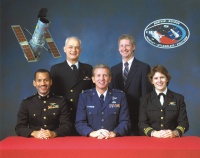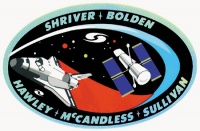STS-31
From The Space Library
 | |
| Organization | NASA-OfficeofSpaceFlight(UnitedStates) |
|---|---|
| Mission type | Human Crew |
| Launch date | April 24, 1990 |
| Launch vehicle | Space Shuttle |
| Carrier rocket | {$Carrier Rocket} |
| Launch site | Cape Canaveral, United States |
| COSPAR ID | 1990-037A |
| Mass | {$Mass} |
| Experiments | Here |
| Alternate Names | 20579 |
| Nominal Power | {$Nominal Power} |
| Additional Information | Here |
| Data Collection | Here |
| Payload Mass Up | 13005.85 kg |
STS-31 was the tenth launch of the shuttle Discovery. On board were Loren Shriver, Charles Bolden, Bruce McCandless, Steven Hawley, and Kathryn Sullivan. The main purpose of this mission was to deploy the Hubble Space Telescope (HST) astronomical observatory. It was designed to operate above the earth's turbulent and obscuring atmosphere to observe celestial objects at ultraviolet, visible and near-infrared wavelengths. This was a joint NASA-ESA effort. The rest of the mission was devoted to photography and onboard experiments. To launch HST into an orbit that guaranteed longevity, Discovery soared to 600 km - the highest shuttle altitude to date. The record height permitted the crew to photograph earth's large scale geographic features not apparent from lower orbits. Motion pictures were recorded by two IMAX cameras. Experiment activity included a biomedical technology study, advanced materials research; particle contamination and ionizing radiation measurements; and student science project studying zero gravity effects on electronic arcs. Discovery's reentry from its higher than usual orbit call for a 4-mn, 58-sec deorbit burn, the longest in shuttle history. It touched down on Edwards AFB runway 22 at 13:49, April 29, after 5 days, 1 hr, 16 mn.

